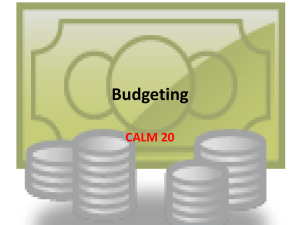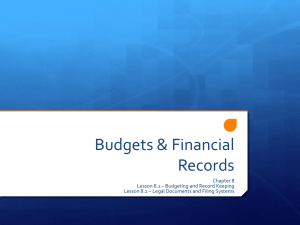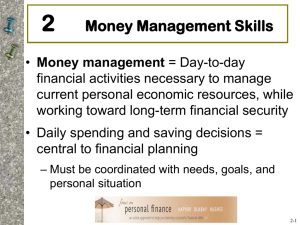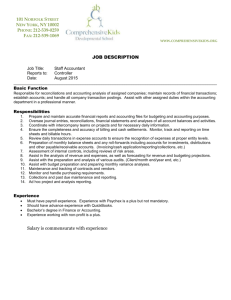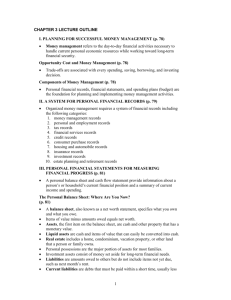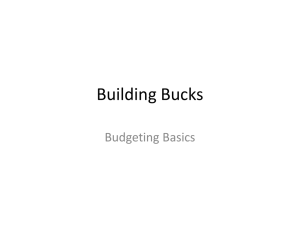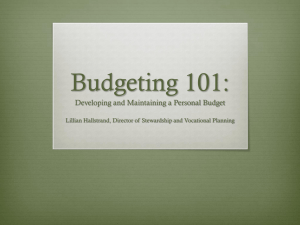Chap003
advertisement
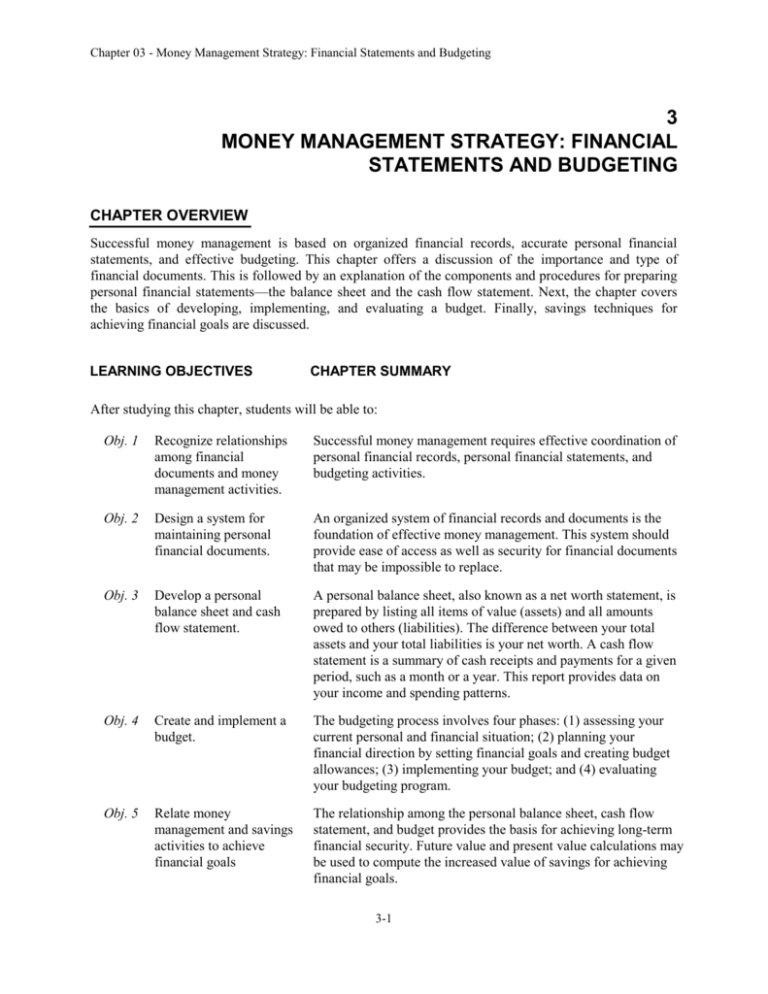
Chapter 03 - Money Management Strategy: Financial Statements and Budgeting 3 MONEY MANAGEMENT STRATEGY: FINANCIAL STATEMENTS AND BUDGETING CHAPTER OVERVIEW Successful money management is based on organized financial records, accurate personal financial statements, and effective budgeting. This chapter offers a discussion of the importance and type of financial documents. This is followed by an explanation of the components and procedures for preparing personal financial statements—the balance sheet and the cash flow statement. Next, the chapter covers the basics of developing, implementing, and evaluating a budget. Finally, savings techniques for achieving financial goals are discussed. LEARNING OBJECTIVES CHAPTER SUMMARY After studying this chapter, students will be able to: Obj. 1 Recognize relationships among financial documents and money management activities. Successful money management requires effective coordination of personal financial records, personal financial statements, and budgeting activities. Obj. 2 Design a system for maintaining personal financial documents. An organized system of financial records and documents is the foundation of effective money management. This system should provide ease of access as well as security for financial documents that may be impossible to replace. Obj. 3 Develop a personal balance sheet and cash flow statement. A personal balance sheet, also known as a net worth statement, is prepared by listing all items of value (assets) and all amounts owed to others (liabilities). The difference between your total assets and your total liabilities is your net worth. A cash flow statement is a summary of cash receipts and payments for a given period, such as a month or a year. This report provides data on your income and spending patterns. Obj. 4 Create and implement a budget. The budgeting process involves four phases: (1) assessing your current personal and financial situation; (2) planning your financial direction by setting financial goals and creating budget allowances; (3) implementing your budget; and (4) evaluating your budgeting program. Obj. 5 Relate money management and savings activities to achieve financial goals The relationship among the personal balance sheet, cash flow statement, and budget provides the basis for achieving long-term financial security. Future value and present value calculations may be used to compute the increased value of savings for achieving financial goals. 3-1 Chapter 03 - Money Management Strategy: Financial Statements and Budgeting INTRODUCTORY ACTIVITIES Ask students to comment on their responses to the “My Life” chapter opening exercise (pp. 77-78). Point out the learning objectives (p.77) in an effort to highlight the key points in the chapter. Ask students to provide examples of problems that could result from not having a definite system for storing personal financial records and documents. Point out common methods of budgeting that help a household achieve financial goals and prevent money problems. CHAPTER 3 OUTLINE I. Successful Money Management A. Opportunity Cost and Money Management B. Components of Money Management II. A System for Personal Financial Records A. Money Management Records B. Personal and Employment Records C. Tax Records D. Financial Services Records E. Credit Records F. Consumer Purchase Records G. Housing and Automobile Records H. Insurance Records I. Investment Records J. Estate Planning and Retirement Records III. Personal Financial Statements A. The Personal Balance Sheet: Where Are You Now? 1. Listing Items of Value 2. Determining Amounts Owed 3. Computing Net Worth B. Evaluating Your Financial Position C. The Cash Flow Statement: Where Did Your Money Go? 1. Record Income 2. Record Cash Outflows 3. Determine Net Cash Flow 3-2 Chapter 03 - Money Management Strategy: Financial Statements and Budgeting IV. Budgeting for Skilled Money Management A. The Budgeting Process Step 1. Setting Financial Goals Step 2. Estimating Income Step 3. Budgeting Emergency Fund and Savings Step 4. Budgeting Fixed Expenses Step 5. Budgeting Variable Expenses Step 6. Recording Spending Amounts Step 7. Reviewing Spending and Saving Patterns B. Characteristics of Successful Budgeting V. Money Management and Achieving Financial Goals A. Identifying Savings Goals B. Selecting a Savings Technique C. Calculating Savings Amounts 3-3 Chapter 03 - Money Management Strategy: Financial Statements and Budgeting CHAPTER 3 LECTURE OUTLINE Instructional Suggestions I. SUCCESSFUL MONEY MANAGEMENT (p. 78) Money management refers to the day-to-day financial activities necessary to handle current personal economic resources while working toward long-term financial security. Text Highlight: The list on pages 78-79 points out tradeoffs associated with money management activities and decisions. Use PPT slides 3-2 to 3-6 Concept Check 3-1 (p. 79) Opportunity Cost and Money Management (p. 78) Trade-offs are associated with every spending, saving, borrowing, and investing decision. Components of Money Management (p. 79) Personal financial records, financial statements, and spending plans (budget) are the foundation for planning and implementing money management activities. CHAPTER 3 LECTURE OUTLINE Instructional Suggestions II. A SYSTEM FOR PERSONAL FINANCIAL RECORDS (p. 80) Organized money management requires a system of financial records including the following categories: 1. money management records 2. personal and employment records 3. tax records 4. financial services records 5. credit records 6. consumer purchase records 7. housing and automobile records 8. insurance records 9. investment records 10. estate planning and retirement records 3-4 Exercise: Have students suggest methods that could be used to organize and quickly access personal financial documents and records. Use PPT slides 3-7 to 3-11. Concept Check 3-2 (p. 82) Chapter 03 - Money Management Strategy: Financial Statements and Budgeting CHAPTER 3 LECTURE OUTLINE Instructional Suggestions III. PERSONAL FINANCIAL STATEMENTS (p. 82) A personal balance sheet and cash flow statement provide information about a person’s or household’s current financial position and a summary of current income and spending. Use PPT slide 3-12. Discussion Question: How accurate is a balance sheet for measuring the financial progress of an individual or household? Use PPT slides 3-13 to 3-15. Text Highlight (p. 84) provides a summary of financial ratios The Personal Balance Sheet: Where Are You Now? (p. 82) A balance sheet, also known as a net worth statement, specifies what you own and what you owe. Items of value minus amounts owed equals net worth. Assets, the first item on the balance sheet, are cash and other property that has a monetary value. Liquid assets are cash and items of value that can easily be converted into cash. Real estate includes a home, condominium, vacation property, or other land that a person or family owns. Personal possessions are the major portion of assets for most families. Investment assets consist of money set aside for longterm financial needs. Liabilities are amounts owed to others but do not include items not yet due, such as next month’s rent. Current liabilities are debts that must be paid within a short time, usually less than a year. Long-term liabilities are debts that are not required to be paid in full until more than a year from now. Your net worth is the difference between your total assets and your total liabilities: Assets - Liabilities = Net worth The balance sheet of a business is usually expressed as: Assets = Liabilities + Net worth Insolvency is the inability to pay debts when they are due; it occurs when a person’s liabilities far exceed his or her available assets. Evaluating Your Financial Position (p. 86) A person or household experiences financial improvement if net worth increases over time. 3-5 Chapter 03 - Money Management Strategy: Financial Statements and Budgeting CHAPTER 3 LECTURE OUTLINE Instructional Suggestions Debt ratio—liabilities divided by net worth—may be used to indicate a person’s financial situation; a low debt ratio is desired. Current ratio—liquid assets divided by current liabilities—how well a person will be able to pay upcoming debts. Liquidity ratio—liquid assets divided by monthly expenses—indicates the number of months that expenses can be paid if an emergency arises. Debt-payment ratio—monthly credit payments divided by take-home pay—provides an indication of how much of a person’s earnings goes for debt payments (excluding a home mortgage). Savings ratio—amount saved each month divided by gross income—financial experts recommend a savings rate of about 10 percent. The Cash Flow Statement: Where Did Your Money Go? (p. 85) Cash flow is the actual inflow and outflow of cash during a given time period. A cash flow statement is a summary of cash receipts and payments for a given period, such as a month or a year. Income is the inflows of cash to an individual or a household. For most people, the main source of income is money received from a job. Cash payments for living expenses and other items make up the second component of a cash flow statement. Fixed expenses are payments that do not vary from month to month. Variable expenses are flexible payments that change from month to month. The difference between your income and your cash outflows can be either a positive (surplus) or negative (deficit) cash flow. A deficit exists if more cash goes out than comes in during a month. This amount must be made up by withdrawals from savings or borrowing. 3-6 Discussion Question: What information does a cash flow statement provide that is not available on a personal balance sheet? Use PPT slides 3-16 to 3-18. Exercise: Have students list all the sources of income (cash inflows available for spending) for people in our society. Discussion Question: What relationship exists between the balance sheet and cash flow statement? Concept Check 3-3 (p. 88) Chapter 03 - Money Management Strategy: Financial Statements and Budgeting CHAPTER 3 LECTURE OUTLINE Instructional Suggestions IV. BUDGETING FOR SKILLED MONEY MANAGEMENT (p. 88) A budget, or spending plan, is necessary for successful financial planning. The main purposes of a budget are to help you 1. live within your income 2. spend your money wisely 3. reach your financial goals 4. prepare for financial emergencies 5. develop wise financial management habits The Budgeting Process (p. 89) A personal balance sheet is an effective scorecard for assessing personal economic progress. Your lifestyle is how you spend your time and money and is strongly influenced by your career, family, and personal values. Step 1. Setting Financial Goals (p. 89) Financial goals are plans for future activities that require you to plan spending, savings, and investing. How much you budget for various items will depend on current needs and plans for the future. Sources that can assist with planning your spending include: your cash flow statement sample budgets from government reports articles in personal financial planning magazines estimates of future income and expected inflation Step 2. Estimating Income (p. 90) Available money should be estimated for a given time period—such as a month. Income variations (due to seasonal work or sales commissions) should be based on the recent past and realistic expectations. Step 3. Budgeting an Emergency Fund and Savings (p. 90) An emergency fund and savings for irregular payments should be first set aside to avoid not having anything left for savings. 3-7 Use PPT slide 3-19. Discussion Question: Is every individual and household forced to budget, with some more organized and planned than others? Exercise: Have students suggest common financial goals. Use PPT slide 3-20. Chapter 03 - Money Management Strategy: Financial Statements and Budgeting CHAPTER 3 LECTURE OUTLINE Instructional Suggestions Step 4. Budgeting Fixed Expenses (p. 92) Text Highlight: Exhibit 3-8 (page 91) provides suggested budget allocations for different life situations. Exercise: Have students allocate budget categories (using percentages) for different household situations. Characteristics of Successful Budgeting (p. 95) Use PPT slides 3-21 and 3-22. Discussion Question: What factors can contribute to unsuccessful budgeting? How can these situations be avoided? Concept Check 3-4 (p. 96) Definite obligations (rent, mortgage, and credit payments) should be allocated first. Assigning amounts to spending categories can be based on your cash flow statement, government data, current magazine articles, and estimates of future income and expenses. A “spending diary” of past expenses can also assist with this task. Step 5. Budgeting Variable Expenses (p. 92) Planning for variable expenses is more difficult than fixed expenses. These expenses will fluctuate based on household situation, time of the year, health, economic conditions, and other factors. Step 6. Recording Spending Amounts (p. 93) A budget variance is the difference between amount budgeted and the actual amount received or spent. A deficit exists when actual spending exceeds planned spending. A surplus is when actual spending is less than planned spending. Step 7. Reviewing Spending and Saving Patterns (p. 94) The results of your budget may be obvious—having extra cash, falling behind in payments. Or the results may need to be reviewed in detail to determine areas of needed changes. The most common overspending areas are entertainment and food, especially awayfrom-home meals. At this point of the budgeting process, you should also evaluate, reassess, and revise your financial goals. A successful budget should be: well-planned realistic flexible clearly communicated 3-8 Chapter 03 - Money Management Strategy: Financial Statements and Budgeting CHAPTER 3 LECTURE OUTLINE Instructional Suggestions V. MONEY MANAGEMENT AND ACHIEVING FINANCIAL GOALS (p. 96) PPT Slide 3-23 Text Highlight: Page 94 shows the relationship among a cash flow statement, the personal balance sheet, and a budget. Identifying Saving Goals (p. 97) Use PPT slide 3-24. Current Example: People unable to save regularly are usually: The personal financial statements and budget can be used to achieve financial goals with 1. the balance sheet reporting your current financial position—where you are now. 2. the cash flow statement: telling you what you received and spent over the past month. 3. the budget: planning spending and saving to achieve financial goals. People commonly prepare a balance sheet on a periodic basis, such as every three or six months. Between those points in time, the budget and cash flow statement help you plan and measure spending and saving activities. The budget would serve to plan your spending and saving between these points in time, and your cash flow statement of income and outflows would document your actual spending and saving. Changes in net worth result from cash inflows and outflows. In periods when outflows exceed your inflows, you must draw on savings or borrow (buy on credit). When this happens, lower assets (savings) or higher liabilities (due to the use of credit) result in a lower net worth. When inflows exceed outflows, putting money into savings or paying off debts will result in a higher net worth. Common reasons for saving include: to set aside money for irregular or unexpected expenses to replace expensive items to buy special items to provide for long-term expenses to earn interest for additional income individuals without specific savings goals people who always seem to use up savings for unexpected expenses Selecting a Savings Technique (p. 97) those who overuse credit people who buy to have the same things as others Since most people find saving difficult, financial advisers suggest several methods: write a check each payday and deposit it in a 3-9 Chapter 03 - Money Management Strategy: Financial Statements and Budgeting CHAPTER 3 LECTURE OUTLINE Instructional Suggestions distant financial institution use payroll deduction save coins spend less on certain items individuals who lack common financial goals with other family members Calculating Savings Amounts (p. 98) To achieve financial objectives, you should convert your savings goals into specific amounts. Your use of an interest-earning savings plan is vital to the growth of your money and the achievement of your financial goals. Concept Check 3-5 (p. 98) CONCLUDING ACTIVITIES Point out the chapter summary (p. 99) and key terms in the text margin. Use the “My Life Stage” feature (p. __) to highlight the main financial planning activities from the chapter for various ages and life situations. Discuss selected end-of-chapter Financial Planning Problems, Financial Planning Activities, Life Situation Case, and Digital Case. Use the Chapter Quiz in the Instructor’s Manual. Refer students to activities and readings in the Student Resource Manual for Chapter 3. WORKSHEETS FROM PERSONAL FINANCIAL PLANNER FOR USE WITH CHAPTER 3 Use the “Your Personal Financial Planner in Action” (p. 103) activities to encourage students to plan and implement various personal financial decisions. Sheet 14 Financial Documents and Records Sheet 15 Personal Balance Sheet Sheet 16 Personal Cash Flow Statement Sheet 17 Cash Budget Sheet 18 Annual Budget Summary Sheet 19 College Education Cost Analysis/Savings Plan 3-10 Chapter 03 - Money Management Strategy: Financial Statements and Budgeting CHAPTER 3 QUIZ ANSWERS True-False Multiple Choice 1. F (p. 80-81) 6. A (p. 88) 2. T (pp. 82) 7. C (p. 83) 3. F (p. 84) 8. D (p. 84) 4. T (pp. 84-85) 9. B (p. 85) 5. T (p. 93) 10. B (p. 87, 92) Name ________________________________________ Date____________________________ CHAPTER 3 QUIZ TRUE-FALSE _____1. Most financial records should be kept in a safe-deposit box. _____2. A personal balance sheet reports the financial position of a person or family on a given date. _____3. Assets represent amounts owed to others that must be paid within the next year. _____4. Spending less than your income will increase net worth. _____5. A budget deficit exists when actual spending exceeds projected spending. MULTIPLE CHOICE _____6. A(n) __________ is a specific plan for spending. a. budget b. balance sheet c. income statement d. bank statement _____7. An example of a liquid asset would be a. a home. b. an automobile. c. a checking account. d. retirement account. _____8. __________ represents amounts owed to others. a. Current assets b. Expenses c. Mutual funds d. Liabilities 3-11 Chapter 03 - Money Management Strategy: Financial Statements and Budgeting _____9. A personal cash flow statement presents a. amounts earned from savings. b. income and payments. c. assets and liabilities. d. amounts owed to others. _____10. Definite financial obligations are referred to as a. variable expenses. b. fixed expenses. c. equity. d. investment assets. SUPPLEMENTARY LECTURE Financial Ratios to Measure and Evaluate Financial Progress Type A. Debt ratio Calculations Example liabilities divided by net worth $50,000/$40,000 = 1.25 Interpretation: These items express the relationship between your debts and personal net worth. A lower debt ratio is desired. B. Current ratio liquid assets divided by current liabilities $7,000/$4,000 = 1.75 Interpretation: Indicates how well you will be able to pay upcoming debts. A higher number is more desirable. C. Liquidity ratio liquid assets divided by monthly expenses $7,000/$2,800 = 2.5 Interpretation: Indicates the number of months a person will be able to pay expenses if an emergency situation arises. Again, a higher number is desired especially if uncertainty exists regarding continual employment. D. Solvency ratio total assets divided by total liabilities $98,000/$67,000 = 1.46 Interpretation: Shows the relationship between the value of assets and what is owed. A higher number is desired. E. Debt Payments ratio monthly credit payments divided by monthly take $450/$2,500 = 0.18 Interpretation: Expresses portion of monthly earnings going for credit payments. A lower ratio is 3-12 Chapter 03 - Money Management Strategy: Financial Statements and Budgeting desired. F. Savings ratio additions to savings plans divided by take-home pay $2,080/$32,800 = 0.065 Interpretation: Presents the portion of annual earnings that has been saved. G. Investment assets ratio investment assets divided by net worth $77,000/$101,000 = 0.76 Interpretation: Indicates portion of net worth that contributes to long-term financial goals. ANSWERS TO CONCEPT QUESTIONS, PROBLEMS, FINANCIAL PLANNING ACTIVITIES, FINANCIAL PLANNING CASE, AND CONTINUING CASE CONCEPT QUESTIONS Concept Check 3-1 (p. 79) 1. What opportunity costs are associated with money management activities? Spending money on current living expenses reduces the amount that can be used for saving and investing toward long-term financial security. Saving and investing for the future reduce the amount that can be spent now. Buying on credit results in payments later and a reduction in the amount of future income available for spending. Using savings for purchases results in lost interest earnings and an inability to use savings for other purposes. Engaging in comparison shopping can save money and improve the quality of purchases but uses up something of value that cannot be replaced—your time. Non-monetary opportunity costs associated with money management activities include time and effort for creating and maintaining a financial record keeping system; a personal decision to have an organized financial existence; possible disagreements among family members due to poor financial records; or weak budgeting techniques. (pp. 78-79) 2. What are the three major money management activities? The three major money management activities are (1) storing and maintaining financial records and documents, (2) creating personal financial statements, and (3) creating and implementing a budget. (p. 79) 3-13 Chapter 03 - Money Management Strategy: Financial Statements and Budgeting Action Application: This activity can create a foundation for class discussion and provide students with a basis for studying this chapter and improving their money management skills. Concept Check 3-2 (p. 79) 1. What are the benefits of an organized system of financial records and documents? The benefits of an organized financial record system are: Handling daily business affairs, including the payment of bills on time. Planning and measuring financial progress. Completing required tax reports. Making effective investment decisions. Determining available resources for current and future buying. (p. 80) 2. What suggestions would you give for creating a system for organizing and storing financial records and documents? Most financial documents will either be kept in a home file or a safe-deposit box depending on the importance and need to access the record. Documents that are difficult to replace (birth certificates, contracts, stock certificates) should be kept in a safe-deposit box. (Exhibit 3-2, p. 81) 3. What influences the length of time that financial records and documents should be kept? If the documents will need to prove ownership or are related to certain tax matters, they should be kept almost indefinitely. Normally a tax audit will go back only three years, but under certain circumstances the Internal Revenue Service may request information six years back. (p. 80) Action Application: This activity will help students become aware of common personal finance documents and develop a system for their various records. Concept Check 3-3 (p. 88) 1. What are the main purposes of personal financial statements? Report your current financial position in relation to the value of the items you own and the amounts you owe. Measure your progress toward your financial goals. Maintain information on your financial activities. Provide data that you can use when preparing tax forms or applying for credit. (p. 82) 2. What does a personal balance sheet tell about your financial situation? A balance sheet consists of assets (items of value), liabilities (amounts owed to others), and net worth (the difference between the total assets and total liabilities. (pp. 82-84) 3. How can you use a balance sheet for personal financial planning? Net worth can be used to measure overall progress of your personal financial planning activities. Reductions in your debts can also be an indication of financial progress. (pp. 84-85) 3-14 Chapter 03 - Money Management Strategy: Financial Statements and Budgeting 4. What information does a cash flow statement present? The cash flow statement summarizes actual inflows and outflows of cash during a given time period. The cash flow statement is a report of your spending patterns and can be used to create budget amounts for various expense categories. (pp. 85-88) Action Application: This research activity will provide students with an opportunity to view the balance sheet elements commonly held in our society. Concept Check 3-4 (p. 95) 1. What are the main purposes of a budget? The main purposes of a budget are to help you: Live within your income. Spend your money wisely. Reach your financial goals. Prepare for financial emergencies. Develop wise financial management habits. (pp. 88-89) 2. How does a person’s life situation affect goal setting and amounts allocated for various budget categories? Different life situations will affect household goals and plans for spending based on needs and desires of those involved. Delayed marriage might mean more spending for travel and leisure; deferred parenthood might be due to plans for advanced career training and returning to school; divorce will affect housing size needs and could mean child care expenses. 3. What are the main steps in creating a budget? The main steps in creating a budget are (1) set financial goals, (2) estimate income, (3) budget savings, (4) budget fixed expenses, (5) budget variable expenses, (6) record actual cash inflows and outflows, and compare actual amounts to budgeted amounts, and (7) review spending patterns. (pp. 89-95) 4. What are commonly recommended qualities of a successful budget? A successful budget is usually well planned, realistic, flexible, and clearly communicated. (pp. 96) 5. What actions might you take when evaluating your budgeting program? An evaluation of a budget situation may require reduced spending or efforts to increase income. (pp. 94-95) 3-15 Chapter 03 - Money Management Strategy: Financial Statements and Budgeting Action Application: This activity will allow students to gain practical information about budgeting as well as provide them with an opportunity to develop communication skills. Concept Check 3-5 (p. 98) 1. What are some suggested methods to make saving easy? Suggested savings methods include “pay yourself first,” payroll deduction, saving coins, and eliminating spending on a certain item. (p. 97) 2. What methods are available to calculate amounts needed to reach savings goals? Future value and present value calculations may be used to determine amounts needed to reach savings goals. Action Application: This activity can help students appreciate differences in money management activities based on differences in life situations. PROBLEMS (p. 101) 1. Based on the procedures presented in the chapter, prepare your current personal balance sheet and a cash flow statement for the next month. Solution: A balance sheet represents the financial position of an individual or family on a given date; refer to text pages 82-84 for the process of preparing one and an example. A cash flow statement covers income and payments for a certain time period (such as a month); refer to text pages 85-88 the process and an example. LO: 3 Topic: Creating Personal Financial Statements LOD: Medium Bloom tag: Application 2. Based on the following data, compute the total assets, total liabilities, and net worth. Liquid assets, $4,670 Household assets, $93,780 Investment assets, $14,350 Long-term liabilities, $76,230 Current liabilities, $2,670 3-16 Chapter 03 - Money Management Strategy: Financial Statements and Budgeting Solution: Total assets = $112,800 ($4,670 + 14,350 + 93,780) Total liabilities = $78,900 ($2,670 + $76,230) Net worth = $33,900 ($112,800 - $78,900) LO: 3 Topic: Calculating Balance Sheet Amounts LOD: Medium Bloom tag: Application 3. Use the following items to prepare a balance sheet and a cash flow statement. Determine the total assets, total liabilities, net worth, total cash inflows, and total cash outflows. Rent for the month, $650 Cash in checking account, $450 Spending for food, $345 Current value of automobile, $7,800 Credit card balance, $235 Auto insurance, $230 Stereo equipment, $2,350 Lunches/parking at work, $180 Home computer, $1,500 Clothing purchase, $110 Monthly take-home salary, $1,950 Savings account balance, $1,890 Balance of educational loan, $2,160 Telephone bill paid for month, $65 Loan payment, $80 Household possessions, $3,400 Payment for electricity, $90 Donations to church, $70 Value of stock investment, $860 Restaurant spending, $130 Solution: Total assets = $18,250 ($450 + 1,890 + 7,800 + 2,350 + 1,500 + 3,400 + 860) Total liabilities = $2,395 ($235 + $2,160) Net worth = $15,855 ($18,250 - $2,395) Total cash inflows = $1,950 Total cash outflows = $1,950 ($650 + 345 + 230 + 180 + 110 + 65 + 80 + 90 + 70 + 130) LO: 3 Topic: Preparing a Personal Balance Sheet. LOD: Hard Bloom tag: Application 4. For each of the following situations, compute the missing amount. a. Assets $45,000; liabilities $11,400; net worth $ _____. b. Assets $76,500; liabilities $ _____ ; net worth $13,700. c. Assets $44,280; liabilities $12,965; net worth $ _____. d. Assets $ _____; liabilities $38,345; net worth $52,654. 3-17 Chapter 03 - Money Management Strategy: Financial Statements and Budgeting Solution: a. $33,600 ($45,000 – $11,400) b. $62,800 ($76,500 – $13,700) c. $31,315 ($44,280 – $12,965) d. $90,999 ($38,345 + $52,654) LO: 3 Topic: Computing Balance Sheet Amounts LOD: Medium Bloom tag: Application 5. The Fram family has liabilities of $128,000 and a net worth of $340,000. What is their debt ratio? How would you assess this? Solution: $128,000 / $340,000 = 0.376 represents a ratio of less than 40 percent, which would need to be assessed in relation to previous trends and the ratio of comparable households. LO: 3 Topic: Calculating Financial Ratios. LOD: Medium Bloom tag: Application, analysis 6. Carl Lester has liquid assets of $2,680 and current liabilities of $2,436. What is his current ratio? What comments do you have about this financial position? Solution: $2,680 / $2,436 = 1.1, which might be viewed as lower than would be desirable. LO: 3 Topic: Determining Financial Progress. LOD: Medium Bloom tag: Application, Analysis 7. Fran Bowen created the following budget: Food, $350 Clothing, $100 Transportation, $320 Personal expenses and recreation, $275 Housing, $950 She actually spent $298 for food, $337 for transportation, $982 for housing, $134 for clothing, and $231 for personal expenses and recreation. Calculate the variance for each of these categories, and indicate whether it was a deficit or surplus. Solution: Food $52 surplus; transportation $17 deficit; housing $32 deficit; clothing $34 deficit; personal expenses $44 surplus. LO: 4 Topic: Determining Budget Variances. LOD: Medium Bloom tag: Application 3-18 Chapter 03 - Money Management Strategy: Financial Statements and Budgeting 8. Bill and Sally Kaplan have an annual spending plan that amounts to $36,000. If inflation is 3 percent a year for the next three years, what amount will the Kaplans need for their living expenses three years from now? Solution: $36,000 1.093 (FV$1, 3%, 3 years) = $39,348 LO: 4 Topic: Calculating the Effect of Inflation LOD: Medium Bloom tag: Application 9. Use future value and present value calculations (see tables in the Chapter 1 appendix) to determine the following. a. The future value of a $500 savings deposit after eight years at an annual interest rate of 3 percent. b. The future value of saving $1,500 a year for five years at an annual interest rate of 4 percent. c. The present value of a $2,000 savings account that will earn 3 percent interest for four years. Solution: a. $500 1.267 = $633.50 b. $1,500 5.416 = $8,124 c. $2,000 0.888 = $1,776 LO: 5 Topic: Computing the Time Value of Money for Savings. LOD: Medium Bloom tag: Application 10. Hal Thomas wants to establish a savings fund from which a community organization could draw $800 a year for 20 years. If the account earns 3 percent, what amount would he have to deposit now to achieve this goal? Solution: $800 14.877 = $11,901.60 LO: 5 Topic: Calculating Present Value of a Savings Fund LOD: Medium Bloom tag: Application 3-19 Chapter 03 - Money Management Strategy: Financial Statements and Budgeting 11. Brenda plans to reduce her spending by $80 a month. Calculate the future value of this increase in saving over the next 10 years. (Assume an annual deposit to her savings account, and an annual interest rate of 5 percent.) Solution: $80 X 12 = $960 X 12.578 (future value of annuity) = $12,074.88 LO: 5 Topic: Future Value of Reduced Spending LOD: Medium Bloom tag: Application 12. Kara George received a $6,000 gift for graduation from her uncle. If she deposits the entire amount in an account paying 3 percent, what will be the value of this gift in 15 years? Solution: $6,000 X 1.558 = $9,348 LO: 5 Topic: Future Value of Savings. LOD: Easy Bloom tag: Application FINANCIAL PLANNING ACTIVITIES (p. 102) 1. Using websites, library sources, friends, relatives, and others, obtain information on common suggestions for successful money management. This activity will provide students with an opportunity to expand their online research skills and to also gain insight into various issues and topics related to money management. 2. Conduct a survey of people of various ages to determine the system they use to keep track of various financial documents and records. Remind students not to ask specific details of budgeted amounts, but rather have them ask general questions about the methods used for budgeting and organizing their financial records. 3. Using 15 and 16 in the Personal Financial Planner, or some other format, prepare a personal balance sheet and cash flow statement. 3-20 Chapter 03 - Money Management Strategy: Financial Statements and Budgeting This will help students start thinking about the practical aspects of personal financial statements for their situations. 4. Use the Web, store visits, or advertisements to determine the software that may be used to prepare personal financial statements, to create a budget, and to monitor spending, saving, and investing. Various software packages for financial planning are available. Samples of these may be obtained or viewed on the Web. 5. Discuss with several people how the budget in Exhibit 3-7 (p. 91) might be changed based on various budget variances. If the household faced a decline in income, what spending areas might be reduced first? This activity can help students better understand problems associated with money management and cash flow. In addition, students can obtain practical advice on coping with this situation. Opinions on this item will vary. Students should be ready to accept different points of views that reflect a person’s life situation, goals, and personal values. 6. Interview a young single person, a young couple, and a middle-aged person about their financial goals and savings habits. What actions do they take to determine and achieve various financial goals? This activity can help students appreciate differences in money management activities based on differences in life situations. FINANCIAL PLANNING CASE A Little Becomes a Lot (p. 102) 1. What money management behaviors did Ken practice that most people neglect? Regular saving was the foundation of Ken’s money management activities. In addition, he planned and implemented a savings plan that provide for both current family needs and long-term financial security. 2. What additional goals might be appropriate for Ken, Alicia, and their children? Possible answers might include: reviewing long-term investments for children’s education and retirement; assessing current and future insurance needs; and having a will and an estate plan. 3. Are your money management activities more like Ken’s or Brian’s? What actions might you take to provide better control of spending and to increase saving? Student answers will vary. Ask students to provide specific information related to/ their responses. Ask students to suggest specific money management actions that might be appropriate for their personal life situation. 3-21 Chapter 03 - Money Management Strategy: Financial Statements and Budgeting CONTINUING CASE Money Management Activities (p. 103) Questions 1. Since a budget is made up of fixed expenses and variable expenses, identify which of Shelby’s expenses fall into each category. Then total each category and compare it to her monthly income to determine if she has a surplus or deficit. a. Fixed expenses: rent $400 + utilities $75 + car insurance $100 = $575 b. Variable expenses: cell phone $50 + credit card payment $40 + gas/car maintenance $100 + cable/internet $45 + groceries $300 + clothing $50 + gifts & donations $50 = $635 c. Monthly income (after taxes) $1450 – (fixed expenses $575 + variable expenses $635 = $1,210) = $240 surplus. 2. Based on the information above, how much should Shelby have in an emergency fund? What steps should she take to reach this amount? Shelby should try to set aside an emergency fund of three to six months of living expenses (fixed and variable expenses combined). Her living expenses totaled $1,210. Therefore, she should aim to set aside between $3,630 and $7,260 in an emergency fund. 3 months of living expenses = $1,210 x 3 = $3,630 6 months of living expenses = $1,210 x 6 = $7,260 Her budget in question 1 above indicates that she should have a surplus of $240 each month. She should set aside a portion of this money each month specifically for her emergency fund until she reaches her goal. 3-22 Chapter 03 - Money Management Strategy: Financial Statements and Budgeting 3. Describe how Shelby might use the following Personal Financial Planner sheets for assessing her financial condition (Creating a Personal Balance Sheet, Creating a Personal Cash Flow Statement, and Developing a Personal Budget). Although student responses may vary, some good answers to this question are: a. Creating a Personal Balance Sheet Shelby can use this form to determine her net worth or current financial position. It identifies her total assets and total liabilities. b. Creating a Personal Cash Flow Statement Shelby can use this form to identify what income she received and what she spent over the past month. By using this form to track her spending, she will be able to identify expenses that can be reduced to help meet her goals. c. Developing a Personal Budget This worksheet will allow Shelby to determine how well she is managing her money to achieve her financial goals. She will be able to identify variances (differences) between her planned activities (planned spending and planned savings) and her actual activities. This will help her to make better money management decisions on a monthly basis. DAILY SPENDING DAIRY (p. 102) This activity will help students better plan their spending for both short-term and long-term financial decisions. 3-23 Chapter 03 - Money Management Strategy: Financial Statements and Budgeting TM 3-1 Creating and Implementing a Budget (Exhibit 3-5) 3-24
